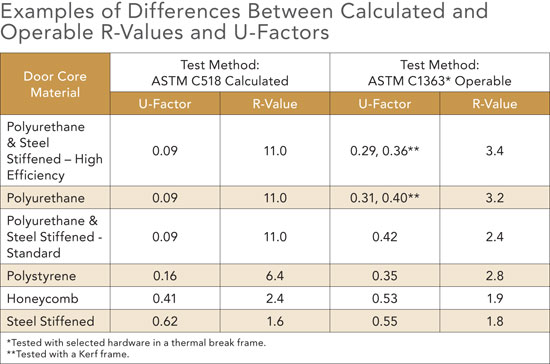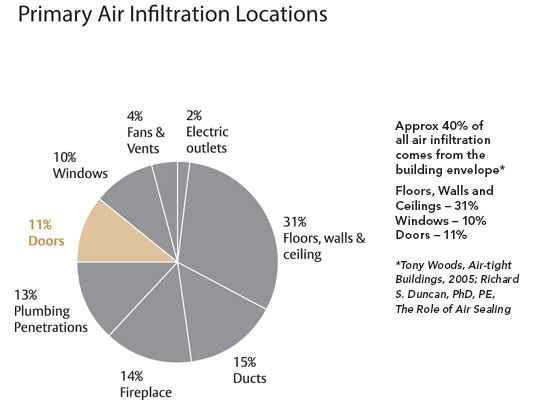Door Opening Solutions in LEED for Healthcare
Thermal Control Strategies
Just as proper attention to insulation in wall assemblies improves energy performance, properly insulated doors lower the U-factor of an opening. Thermal imaging of exterior walls with doors reveals just how dramatic a difference may exist between a well-insulated wall assembly and a door system. Hollow metal doors commonly used in commercial building envelopes are usually constructed from sheet metal in 20-, 18-, 16-, and 14-gauge thicknesses. The core or interior space between the metal faces provides support and integrity to the door but it is only when this core is filled with insulating material that improved energy performance occurs. Door manufacturers have traditionally promoted the calculated R- and U-values for their products as determined by a formula, rather than a performance test. Unfortunately, the calculated core is not usually indicative of real-life performance. ASTM C1363 is the most current test standard for operable thermal transmittance, replacing ASTM C236. Testing a door under this method will result in an “operable value” which gives a more realistic estimate of the total performance of a door opening assembly including the door, frame, and gasketing performance as a unit. Generally speaking, a thermally broken door filled with polyurethane insulation in the core, coupled with a thermally broken frame, will perform the best with an operable U-value of U-.29 compared to a calculated value of U-.09.
 |
When accounting for thermal performance in exterior doors, the tested operable thermal value is more accurate than calculated values. Image courtesy of ASSA ABLOY |
 |
|
Image courtesy of ASSA ABLOY |
| Advocate Lutheran General Hospital is the first LEED Gold Hospital in the Midwest |
||
|
Widespread use of sustainable construction practices and building products made with recycled content and other green materials enabled the Advocate Lutheran General Hospital in Park Ridge, Illinois, to achieve LEED Gold certification. Sustainability and security go hand-in-hand at Advocate Lutheran General Hospital. A recent addition at the healthcare facility achieved LEED Gold certification, making it the first hospital in the Midwest to attain this lofty ranking offered by the United States Green Building Council (USGBC). Among the building components used in the new addition are door and hardware products that played a notable role in the Gold certification.
The healthcare conglomerate is committed to improving patient outcomes by creating environments that are therapeutic, efficient and restorative. These values weighed heavily in the design of the 192-room patient tower completed in 2009. The tower includes innovative safety and comfort features, a focus on family-centered care and an environmentally friendly design that includes the use of building products made with high percentages of recycled material and low-VOC (volatile organic compound) interior finishes. Hollow metal doors and frames were made in nearby Mason City, Iowa, and are produced with roughly 40 percent recycled steel. The doors also meet stringent GREENGUARD testing for VOC requirements and exceed operable thermal transmission and air leakage requirements of LEED, providing Lutheran General with an extremely energy-efficient building envelope. The hinges and door closers are made with over 50 percent recycled content, while flat goods and trim products contain between 56-90 percent recycled materials. From a security perspective, the facility incorporated 180 pin pad locks that require a security code to gain entry to the doorway in addition to exit devices and a central key system. Visitors to Lutheran General’s patient tower can learn more about the hospital’s LEED journey by stopping in the “Why Green Gallery” on the first floor of the patient tower. The gallery highlights the many ways the building respects the environment while providing healthier, more comfortable surroundings for patients, their families, and the staff. The gallery also describes what Lutheran General is doing to help the community and environment stay healthy. |
Beyond the door panel itself, the details of the door frame are important. Consider that when addressing energy performance of windows, thermal breaks are pretty much standard practice for metal window frames. Since door frames are also made of metal, a thermal break consisting of an insulated material is needed to stop or at least slow heat transmission through the frame. Thermal break door frames can improve an opening's overall U-factor since they provide a positive thermal break within the frame profile, thus inhibiting heat transfer. In cold climates, they deliver the maximum protection against condensation and potential frost build-up. Further, many designs allow for weatherstripping to be easily inserted and removable both initially and for future replacements as needed.










